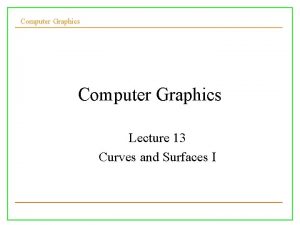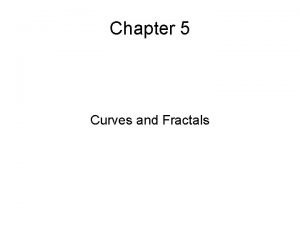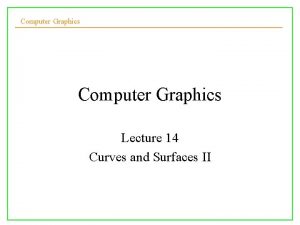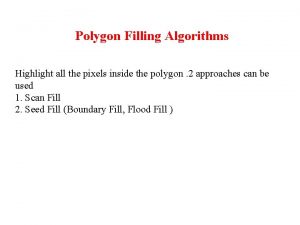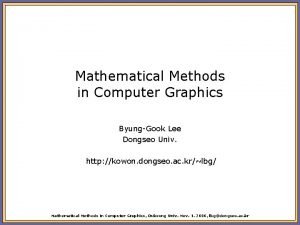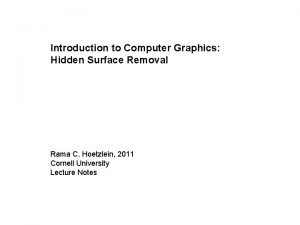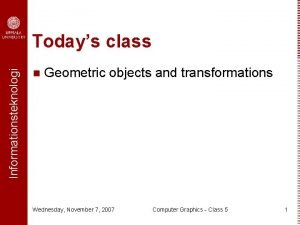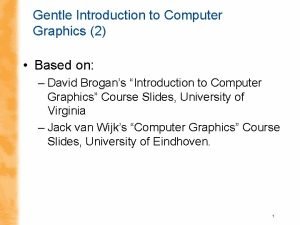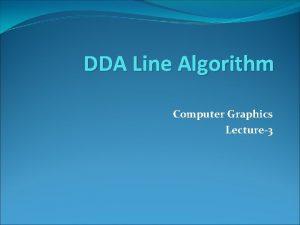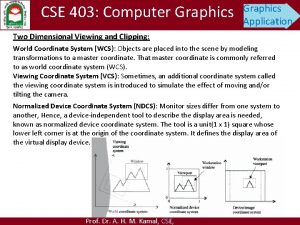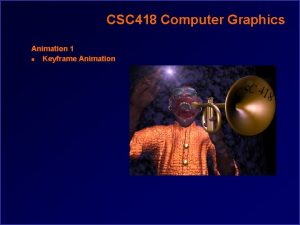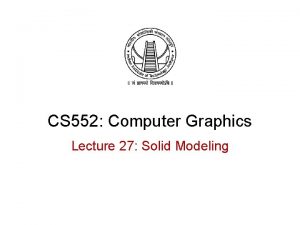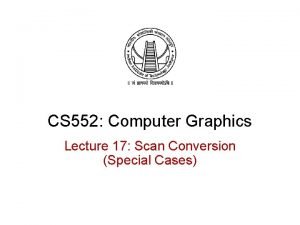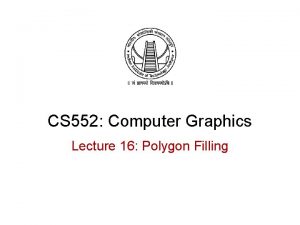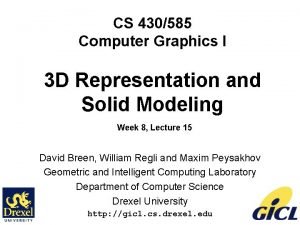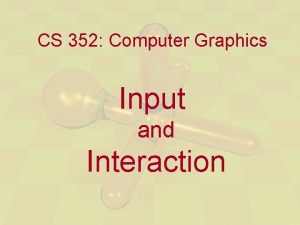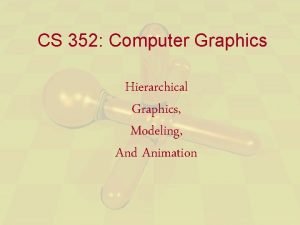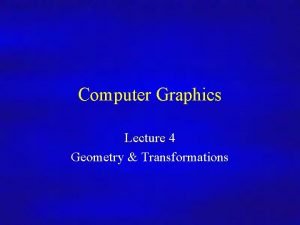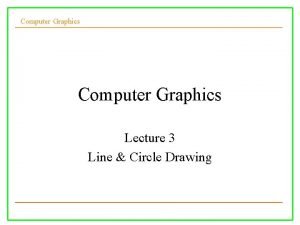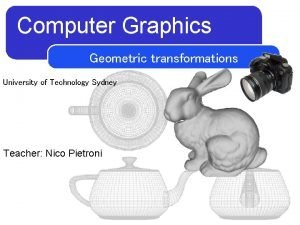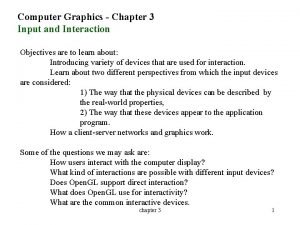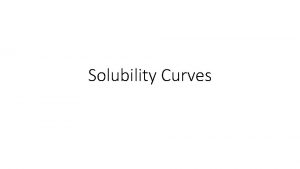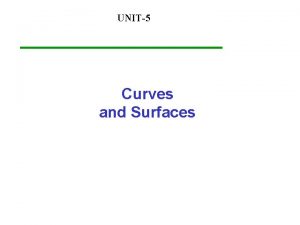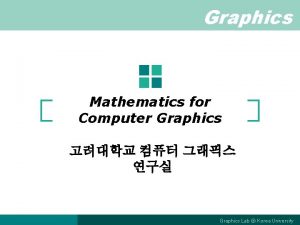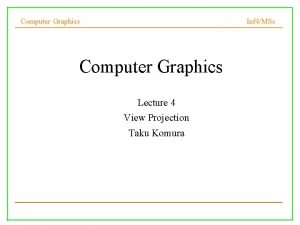Computer Graphics Lecture 35 CURVES Taqdees A Siddiqi






























































- Slides: 62

Computer Graphics Lecture 35

CURVES Taqdees A. Siddiqi cs 602@vu. edu. pk

Curves

We all know what a curve is. Today we will explore the mathematical definition of a curve in a form that is very useful to geometric modeling and other computer graphics applications

The mathematics of parametric equations is the basis for Bezier, NURBS (Non Uniform Rational Beta Splines), and Hermite curves

Parametric Equations of a Curve

A parametric curve is one whose defining equations are given in terms of a single, common, independent variable called the parametric variable.

We have already encountered parametric variables in earlier discussions of vectors, lines, and planes.

In three-dimensional space each point on curve has unique set of coordinates: each coordinate is controlled by a separate parametric equation, whose general form looks like


where x(u) stands for some as yet unspecified function in which u is the independent variable;

for example, x(u) = au 2 + bu + c, and similarly for y(u) and z(u). It is important to understand that each of these is an independent expression

The dependent variables are the x, y, and z coordinates themselves, because their values depend on the value of the parametric variable u

Figure 1: point of a curve defined by a vector.

Each point on a curve is defined by a vector p (figure 1). The components of this vector are x(u), y(u), and z(u). we express this as

which says that the vector p is a function of the parametric variable u.

There is a lot of information in equation 2. when we expand it into component form, it becomes

There are only a few simple rules that we must follow to design these mathematical functions

1) define each component by a single, common parametric variable, and 2) make sure that each point on the curve corresponds to a unique value of the parametric variable.

Plane Curves

To define plane curves, we use parametric functions that are second-degree polynomials:


• where the a, b, and c terms are constant coefficients. • We can combine x(u), y(u), z(u), and their respective coefficients into an equivalent, more concise, vector equation:


We allow the parametric variable to take on values only in the interval 0 u 1.

It can generate conic curves but it cannot generate curve with an inflection point, like an S-shaped curve, no matter what values we select for the coefficients a, b, c. to do this requires a cubic polynomial.

To one of the end points we assign u = 0, and to the other u = 1. To the intermediate point, we arbitrarily assign u = 0. 5. We can write these points as

• P 0 = [x 0 y 0 • P 0. 5 = [x 0. 5 y 0. 5 • P 1 = [x 1 y 1 z 0] z 0. 5] …(6) z 1]

• Where the subscripts indicate the value of the parametric variable at each point. • Now we solve equations 4 for the ax, bx, …, cz coefficients in terms of these points. Thus, for x at u = 0, u =0. 5, and u =1, we have

• x 0 = cx • x 0. 5 = 0. 25 ax + 0. 5 bx + cx …(7) • x 1 = a x + b x + cx • with similar equations for y, and z.

Figure 2: A plane curve defined by three points

• Next we solve these three equations in three unknowns for ax, bx, and cx, finding • ax = 2 x 0 - 4 x 0. 5 + 2 x 1 • bx = -3 x 0 + 4 x 0. 5 + x 1 …(8) • cx = x 0

• Substituting this result in to equation 4 yields • x(u) = (2 x 0 - 4 x 0. 5 + 2 x 1 ) u 2 + (-3 x 0 + 4 x 0. 5 - x 1) u + x 0 …(9)

• Again, there are equivalent expressions for y(u) and z(u). • We rewrite equation 9 as follows:

x(u) = (2 u 2 – 3 u + 1) x 0 + (-4 u 2 + 4 u)x 0. 5 + 2 (2 u – u) x 1 …(10)

• Using this result and equivalent expressions for y(u) and z(u), we combine them into a single vector equation:

P(u) = (2 u 2 – 3 u + 1) P 0 + (-4 u 2 + 4 u)P 0. 5 + 2 (2 u – u) P 1 …(11)

Equation 11 produces the same curve as Equation 5. The curve will always lie in a plane no matter what three points we choose.

Furthermore, it is interesting to note that the point P 0. 5 which is on the curve at u= 0. 5, is not necessarily half way along the length of the curve between p 0 and p 1

Figure 3: Curve defined by three non-uniformly spaced points.

Equation 5 is the algebraic form and equation 11 is the geometric form. Each of these equations can be written more compactly with matrices

So now we rewrite equation 5 using the following substitutions:



And finally we obtain

Remember that A is actually a matrix of vectors, so that

• The nine terms on the right are called the algebraic coefficients. • Next, we convert equation 11 into matrix form. The right-hand side looks like the product of two matrices

and This means that

Using the following substitutions

and

where P is the control point matrix and the nine terms on the right are its elements or the geometric coefficients, we can now write


• This is the matrix version of the geometric form. • Because it is the same curve in algebraic form, p(u)=UA, or geometric form, p(u)=FP, we can write

The F matrix is itself the product of two other matrices

The matrix on the left we recognize as U, and we can denote the other matrix as

This means that

Using this we substitute appropriately to find

Pre-multiplying each side of this equation by 1/U yields

This expresses a simple relationship between the algebraic and geometric coefficients

Or

The matrix M is called a basis transformation matrix, and F is called a blending function matrix.

Computer Graphics Lecture 35
 Faraaz siddiqi
Faraaz siddiqi What are curves in computer graphics
What are curves in computer graphics Fractals deals with curves that are
Fractals deals with curves that are Curves and surfaces for computer graphics
Curves and surfaces for computer graphics Graphics monitor and workstation in computer graphics
Graphics monitor and workstation in computer graphics Dot matrix display ppt
Dot matrix display ppt 01:640:244 lecture notes - lecture 15: plat, idah, farad
01:640:244 lecture notes - lecture 15: plat, idah, farad Computer security 161 cryptocurrency lecture
Computer security 161 cryptocurrency lecture Computer-aided drug design lecture notes
Computer-aided drug design lecture notes Computer architecture notes
Computer architecture notes Isa vs microarchitecture
Isa vs microarchitecture Angel
Angel Define viewing in computer graphics
Define viewing in computer graphics Display devices in computer graphics
Display devices in computer graphics In two dimensional viewing we have?
In two dimensional viewing we have? Shear transformation in computer graphics
Shear transformation in computer graphics Glsl sincos
Glsl sincos Scan conversation
Scan conversation Equation of motion of a rotating rigid body
Equation of motion of a rotating rigid body Region filling in image processing
Region filling in image processing Advantages and disadvantages of scan line fill algorithm
Advantages and disadvantages of scan line fill algorithm Polygon filling algorithm in computer graphics
Polygon filling algorithm in computer graphics Differentiate horizontal and vertical retrace
Differentiate horizontal and vertical retrace Computer graphics
Computer graphics Dda line drawing algorithm in c
Dda line drawing algorithm in c Cs 418 interactive computer graphics
Cs 418 interactive computer graphics Glcreatebuffer
Glcreatebuffer Hidden surface removal algorithm in computer graphics
Hidden surface removal algorithm in computer graphics Achromatic light in computer graphics
Achromatic light in computer graphics What are the interactive input methods? explain in detail.
What are the interactive input methods? explain in detail. Uniform scaling in computer graphics
Uniform scaling in computer graphics Uniform scaling in computer graphics
Uniform scaling in computer graphics Fundamentals of computer graphics
Fundamentals of computer graphics Logical input devices in computer graphics
Logical input devices in computer graphics Sierpinski gasket in computer graphics
Sierpinski gasket in computer graphics Polygon clipping in computer graphics ppt
Polygon clipping in computer graphics ppt Ppt on computer graphics
Ppt on computer graphics Equation of line in computer graphics
Equation of line in computer graphics What is window and viewport in computer graphics
What is window and viewport in computer graphics Keyframe system in computer graphics
Keyframe system in computer graphics Solid
Solid Scan conversion in computer graphics
Scan conversion in computer graphics Region filling and clipping in computer graphics
Region filling and clipping in computer graphics Utah teapot vertex data
Utah teapot vertex data Thick primitives in computer graphics
Thick primitives in computer graphics Interaction in computer graphics
Interaction in computer graphics Computer graphics
Computer graphics Rendering pipeline in computer graphics
Rendering pipeline in computer graphics Scan converting ellipse algorithm in computer graphics
Scan converting ellipse algorithm in computer graphics Srgp in computer graphics
Srgp in computer graphics Types of transformation in computer graphics
Types of transformation in computer graphics Gupta sproull algorithm
Gupta sproull algorithm Uniform scaling in computer graphics
Uniform scaling in computer graphics Input of graphical data in computer graphics
Input of graphical data in computer graphics Sutherland hodgman algorithm in computer graphics
Sutherland hodgman algorithm in computer graphics Amber
Amber Define morphing in computer graphics
Define morphing in computer graphics Frame yv
Frame yv Scanline polygon fill algorithm
Scanline polygon fill algorithm Boundary fill 4(x-1,y, fillcolor,________)
Boundary fill 4(x-1,y, fillcolor,________) Computer graphics code for line drawing
Computer graphics code for line drawing Attributes in computer graphics
Attributes in computer graphics Objectives of computer graphics
Objectives of computer graphics

